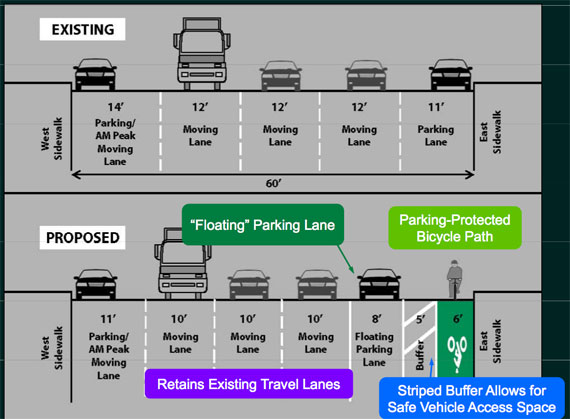CB 7 Committee Backslides With Split Vote on Protected UWS Bike Lane
 DOT’s proposal for Columbus Avenue would create room for a separated bike lane by narrowing, not removing, car lanes. Image: NYCDOT [PDF]
DOT’s proposal for Columbus Avenue would create room for a separated bike lane by narrowing, not removing, car lanes. Image: NYCDOT [PDF]Looks like some Manhattan community board types still want to see their local streets keep that highway-in-the-city feel.
After receiving a request from Manhattan CB 7 in the fall to prepare plans for protected bike lanes on Columbus and Amsterdam Avenues, NYCDOT showed the board’s transportation committee a proposal last night for a bikeway segment on Columbus from 96th Street to 77th Street [PDF]. The plan is to add a protected bike path on the east side of
Columbus, combining design elements from protected lanes that have substantially reduced injuries on other Manhattan streets. DOT Manhattan Borough Commissioner Margaret Forgione told the audience that the Columbus
Avenue project will serve as a one-year trial, after which DOT can
compare before-and-after data on usage and traffic injuries. Bike lane expansions could follow.
Despite the full board’s previous request and all the accumulated evidence documenting the safety gains from similar projects, when it came time to discuss the proposal, the committee split 5 to 5 on a resolution of support.
Local activists have collected hundreds of signatures in favor of protected bike lanes on the Upper West Side, and eight elected officials and the Columbus Avenue BID have signaled their support, so the committee vote is almost certainly not the final word on the project. Even the committee co-chairs who voted against the plan, Dan Zweig and Andrew Albert, said they expected the proposal to come before the full board (whose stance will also be advisory). On Streetsblog we always like to plumb the depths of what goes on at these quasi-representative bodies, so here goes.
First off, the public comment period was a testament to the awareness-building and organizing work of the folks at the Upper West Side Streets Renaissance, who’ve been advocating for safer and more livable streets for years. The standing room-only crowd was overwhelmingly in favor of the project. When the inevitable complaints and anti-cyclist comments surfaced, the next speaker would follow with a jolt of common sense. "There are lawbreakers on all sides," said Michael Rosenthal, who’s been bike commuting for 45 years. "Anything that can be done to reduce fatalities and injuries is terrific."
The outpouring of support for the project didn’t sway the committee co-chairs, however. "This is not the right place for a bike lane," said Zweig, claiming that narrower traffic lanes would somehow further slow down congested rush hour traffic. "I’m sure the drivers who use Columbus were not surveyed." As Zweig had announced a few minutes earlier, he is one of those drivers. But even for motorists like him, it’s hard to see what maintaining the status quo accomplishes, except keeping New Yorkers who want to ride in safety from getting on their bikes.
The DOT plan does not eliminate any traffic lanes and removes a scant 55 parking spaces. All the space allocated to the bike path and pedestrian islands comes from narrowing the excessively wide moving and parking lanes on Columbus Avenue. Reducing travel lanes from 12-foot widths to 10-foot widths is a traffic-calming enhancement that will, in fact, improve safety for everyone, including motorists.
Andrew Albert, the other committee chair, predicted delivery havoc if trucks can’t unload right next to the curb. "You’re going to see real problems with this bike lane," he said. Forgione had earlier explained that DOT could add loading zones on side streets to help deliveries run smoother.
Most of the retailers on Columbus Avenue would probably take issue with Albert’s unwillingness to try something new and make it work. "We’re going to find ways to get around the potential problems we’re going to have with deliveries," said a rep from clothing store Patagonia, "because we’re excited about the additional customers." More than a hundred businesses along the Columbus Avenue corridor
signed on to a thank you letter when CB 7 requested protected bike lanes last fall, according to Tila
Duhaime of the Upper West Side Streets Renaissance.
Like bike lane opponents everywhere who don’t want to come out and say they’re opposed to bike lanes, Zweig and Albert rested their cases on the argument that "this is not the right place for it." This part of Columbus Avenue, however, is ideal for adding bike and pedestrian infrastructure in several ways.
- The project narrows lanes that are currently wide enough for interstate highways, which should slow speeding traffic and make the avenue safer for everybody, motorists and delivery trucks included.
- People will have reasons to bike on this lane. It takes cyclists to a commercial corridor and links to crosstown routes, including the lane on 77th Street where you can ride into Central Park and hook up with the protected bike lane on Broadway.
- It sets the stage for a continuous protected corridor, connected to the Ninth Avenue bike lane.
- If this part of Columbus is, in fact, a challenging segment on which to work out deliveries, doesn’t that make it ideal to try out a new configuration? If the re-design works here, then it can work elsewhere on the corridor.
The next meeting of the full community board is scheduled for June 1. If this project makes it onto the agenda, the vote is shaping up as a nailbiter. Five CB members who don’t sit on the transportation committee turned out last night. When polled, they approved of the project 3 to 2.